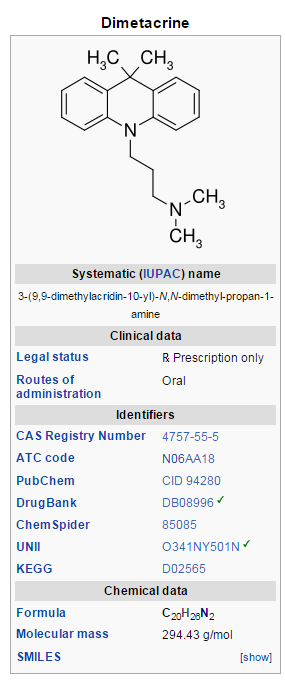Dimetacrine
|
WikiDoc Resources for Dimetacrine |
|
Articles |
|---|
|
Most recent articles on Dimetacrine Most cited articles on Dimetacrine |
|
Media |
|
Powerpoint slides on Dimetacrine |
|
Evidence Based Medicine |
|
Clinical Trials |
|
Ongoing Trials on Dimetacrine at Clinical Trials.gov Clinical Trials on Dimetacrine at Google
|
|
Guidelines / Policies / Govt |
|
US National Guidelines Clearinghouse on Dimetacrine
|
|
Books |
|
News |
|
Commentary |
|
Definitions |
|
Patient Resources / Community |
|
Patient resources on Dimetacrine Discussion groups on Dimetacrine Patient Handouts on Dimetacrine Directions to Hospitals Treating Dimetacrine Risk calculators and risk factors for Dimetacrine
|
|
Healthcare Provider Resources |
|
Causes & Risk Factors for Dimetacrine |
|
Continuing Medical Education (CME) |
|
International |
|
|
|
Business |
|
Experimental / Informatics |
Editor-In-Chief: C. Michael Gibson, M.S., M.D. [1]
Overview
Dimetacrine (Istonil, Istonyl, Linostil, Miroistonil), also known as dimethacrine and acripramine, is a tricyclic antidepressant (TCA) used in Europe and formerly in Japan for the treatment of depression.[1][2][3][4][5] It has imipramine-like effects; though, in a double-blind clinical trial against imipramine, dimetacrine was found to have lower efficacy in comparison and produced more weight loss and abnormal liver tests.[6][7] Little is known about the pharmacology of dimetacrine, but it can be inferred that it acts in a similar manner to other TCAs. If this is indeed the case, dimetacrine may induce severe cardiac toxicity in overdose (a side effect unique to the tricyclic class of antidepressants).
See also
References
- ↑ Dictionary of organic compounds. London: Chapman & Hall. 1996. ISBN 0-412-54090-8.
- ↑ Affective disorders: perspective on ... - Google Books.
- ↑ José Miguel Vela; Helmut Buschmann; Jörg Holenz; Antonio Párraga; Antoni Torrens (2007). Antidepressants, Antipsychotics, Anxiolytics: From Chemistry and Pharmacology to Clinical Application. Weinheim: Wiley-VCH. ISBN 3-527-31058-4.
- ↑ Taen S, Pöldinger W (December 1966). "[Dimethacrine (istonil), an acridane derivative with the antidepressive action]". Schweizerische Medizinische Wochenschrift (in German). 96 (48): 1616–20. PMID 6008540.
- ↑ Meyer R (May 1968). "[Contribution to the clinical evaluation of the antidepressive effect of dimethacrine (Istonil)]". Praxis (in German). 57 (20): 721–3. PMID 5756370.
- ↑ Abuzzahab FS (November 1973). "A double-blind investigation of dimethacrine versus imipramine in hospitalized depressive states". International Journal of Clinical Pharmacology, Therapy and Toxicology. 8 (3): 244–53. PMID 4149236.
- ↑ Mutschler, Ernst; Derendorf, Hartmut (1995). Drug actions: basic principles and therapeutic aspects. Stuttgart, Germany: Medpharm Scientific Pub. ISBN 0-8493-7774-9. Retrieved January 30, 2013.
